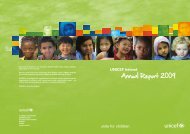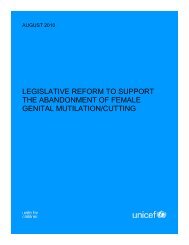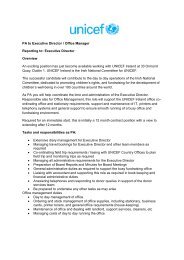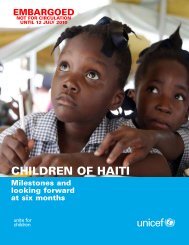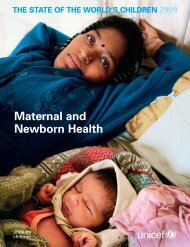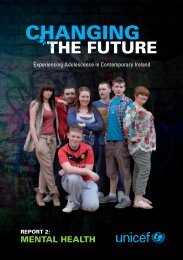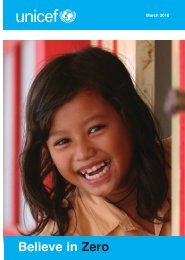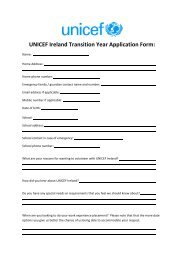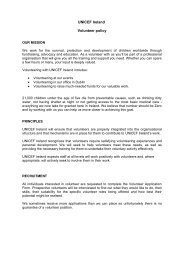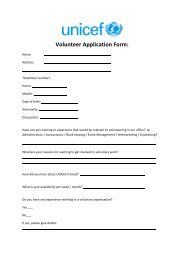Humanitarian Action for Children 2011 - Unicef
Humanitarian Action for Children 2011 - Unicef
Humanitarian Action for Children 2011 - Unicef
- No tags were found...
You also want an ePaper? Increase the reach of your titles
YUMPU automatically turns print PDFs into web optimized ePapers that Google loves.
Kenya<strong>Children</strong> and women in crisisWhile 2010 has seen some improvement in the humanitarian situation in Kenya, progress istempered by the chronic vulnerabilities of emergency-affected populations. Despite recentgood rainfalls, high food prices and the lingering impact of the 2007–2009 drought havemitigated recovery. More than 40,000 children are suffering from severe acute malnutrition 1and weather patterns predicted <strong>for</strong> <strong>2011</strong> could introduce another period of drought. Thecurrent influx of Somali refugees, coupled with the potential <strong>for</strong> displaced populations fromthe Sudan, adds to concerns about refugee and host community welfare and the vulnerabilityof children and women.<strong>Humanitarian</strong>funding at work:Highlights from 2010In mid-2010, an estimatedUS$23,092,245 was needed<strong>for</strong> UNICEF’s humanitarianactivities in Kenya. As ofOctober 2010, a total ofUS$14,177,026 (61 per centof the revised request) hadbeen received. By year-endthese funds enabled UNICEFto achieve a number ofimportant results <strong>for</strong> childrenand women, including:18,350 children treated <strong>for</strong>severe acute malnutrition,with a recovery rate of 84 percent. Measles immunizationreached 284,000 childrenunder 5 years old. Safe waterwas supplied to 313,000people struggling withdrought, flood or cholera;31,500 children had accessto gender-appropriatehygiene and sanitationservices; and 26,500 floodaffectedstudents were ableto continue their educationdespite emergencyconditions.Meeting urgent needs and building resilience in <strong>2011</strong>UNICEF, together with the Government of Kenya, other UN agencies and NGOs, will focuson assisting the most vulnerable people in affected areas of the country. UNICEF co-lead thenutrition, education, child protection and WASH clusters along with the relevant governmentministry. 2 UNICEF expects to reach 1.9 million people living in emergency conditions in <strong>2011</strong>,including around 988,000 girls and 912,000 boys.• Increased coverage of integrated high-impact nutrition interventions – including managementof moderate and severe acute malnutrition, infant and young child feeding, and micronutrientsupplementation – in health facilities and at the community level will benefit 250,000 childrenunder 5 affected by moderate malnutrition, 40,000 children under 5 affected by severe acutemalnutrition, and 55,000 pregnant and lactating women.• Some 85 per cent of children under age 5 in selected districts will be vaccinated <strong>for</strong> measles.At least 1.12 million children and pregnant and lactating women will receive immunization,services to prevent mother-to-child transmission of HIV and obstetric care.• Safe water and sanitation will be provided to 1.6 million disaster- and disease-affected people.• About 15,000 primary-school children in Dadaab, a refugee camp hosting primarily Somalirefugees, will have improved access to education. Awareness-raising among parents aboutthe importance of early childhood development will lead to an additional 40,000 boys andgirls accessing education; 100,000 children will be educated on disaster safety in a schoolenvironment.• A child protection framework will be established in Dadaab, child-friendly spaces will continueto receive support, and up to 150,000 vulnerable children will be protected from separationfrom their families during times of emergency; separated children will be reunited withcaregivers and provided with essential services.Funding requirements <strong>for</strong> <strong>2011</strong>UNICEF is requesting US$16,168,000 <strong>for</strong> its <strong>2011</strong> humanitarian work in Kenya. UNICEF hasaligned its request with the <strong>2011</strong> Consolidated Appeals Process (CAP) requirements. Thisamount represents a decrease of almost US$7 million compared to 2010 due to improvementsin the food security situation; however, continued funding is required to support recovery andprevent deterioration.More in<strong>for</strong>mation on achievements of 2010 and the humanitarian action planned<strong>for</strong> Kenya in <strong>2011</strong> can be found at www.unicef.org/hac<strong>2011</strong> or at the country officewebsite, www.unicef.org/kenya.1. Office of the United Nations <strong>Humanitarian</strong> Coordinator in Kenya, ‘Kenya <strong>Humanitarian</strong> Update’, vol. 65, UnitedNations, New York, 17 October–15 November 2010, p. 3.2. UNICEF co-leads the nutrition cluster with the Ministry of Public Health and Sanitation of Kenya, educationcluster with the Ministry of Education; the child protection cluster with the Ministry of Gender and <strong>Children</strong>’sAffairs; and the WASH cluster with the Ministry of Water and Irrigation.UNICEF EMERGENCY NEEDS FOR <strong>2011</strong> (in US dollars)Total $16,168,0002,001,000 Health1,241,000Child protection500,000Cross-sectoral6,310,000 Nutrition4,378,000 WASH1,198,000 Education540,000 Cluster coordinationKenyawww.unicef.org/hac<strong>2011</strong> | <strong>2011</strong> UNICEF <strong>Humanitarian</strong> <strong>Action</strong> FOR CHILDREN 39




